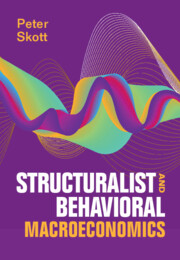Book contents
- Frontmatter
- Contents
- Figures
- Preface and Acknowledgments
- 1 Introduction: The State of Macroeconomics
- 2 The Lucas Critique and Representative Agents
- 3 Household Consumption and Saving
- 4 Saving in a Corporate Economy
- 5 Phillips Curves and the Natural Rate of Unemployment
- 6 Fairness, Money Illusion, and Path Dependency
- 7 Earnings Inequality, Power Bias, and Mismatch
- 8 Macroeconomic Adjustment and Keynes’s Instability Argument
- 9 Growth and Cycles
- 10 Endogenous Growth Cycles with or without Price Flexibility
- 11 Secular Stagnation and Functional Finance
- 12 Concluding Comments: Evidence-Based Macroeconomics and Economic Theory
- References
- Author Index
- Subject Index
3 - Household Consumption and Saving
Published online by Cambridge University Press: 10 November 2023
- Frontmatter
- Contents
- Figures
- Preface and Acknowledgments
- 1 Introduction: The State of Macroeconomics
- 2 The Lucas Critique and Representative Agents
- 3 Household Consumption and Saving
- 4 Saving in a Corporate Economy
- 5 Phillips Curves and the Natural Rate of Unemployment
- 6 Fairness, Money Illusion, and Path Dependency
- 7 Earnings Inequality, Power Bias, and Mismatch
- 8 Macroeconomic Adjustment and Keynes’s Instability Argument
- 9 Growth and Cycles
- 10 Endogenous Growth Cycles with or without Price Flexibility
- 11 Secular Stagnation and Functional Finance
- 12 Concluding Comments: Evidence-Based Macroeconomics and Economic Theory
- References
- Author Index
- Subject Index
Summary
Behavioral economics has demonstrated deviations from the perfect optimization depicted in standard models. Some deviations are trivial and irrelevant for macroeconomics. Others, however, are systematic and affect aggregate outcomes, including aggregate household saving. Pervasive uncertainty and the influence of ‘nudging’ on household retirement saving cast doubt on models of saving that are based on strict optimization and rational expectations. Behavioral evidence also points to possible reasons for under-saving. The well-documented existence of ‘present bias’, not surprisingly, can reduce saving, and simple models demonstrate that peer effects on consumption can also have this effect. Macroeconomic relations should indeed reflect microeconomic behavior and macroeconomics must be ‘behavioral’. But the specification of consumption in contemporary macroeconomic models is based on misleading assumptions about microeconomic behavior. The modeling of aggregate consumption must build on behavioral evidence, address aggregation issues, and consider structural constraints, including credit rationing.
Keywords
- Type
- Chapter
- Information
- Structuralist and Behavioral Macroeconomics , pp. 41 - 69Publisher: Cambridge University PressPrint publication year: 2023

